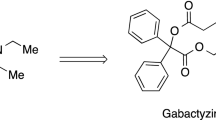Abstract
THE neuropathological effects of dosing dogs over a prolonged period with some monoamine oxidase inhibitors have already been described by us1. Two of the drugs, phenyl-iso-propyl hydrazine (‘JB 516’ or ‘Catron’) and tetra-hydronaphthyl hydrazine, produced strikingly focal bilateral degeneration of the inferior olives. Phenelzine (‘Nardil’) and indanyl carbethoxy hydrazine resulted in oedema and disintegration of sub-cortical myelin in the cerebrum, accompanied by microglial proliferation. It was suggested that perhaps a contributory cause of both types of lesion might be ascribed to elevated levels of brain serotonin.
This is a preview of subscription content, access via your institution
Access options
Subscribe to this journal
Receive 51 print issues and online access
$199.00 per year
only $3.90 per issue
Buy this article
- Purchase on Springer Link
- Instant access to full article PDF
Prices may be subject to local taxes which are calculated during checkout
Similar content being viewed by others
References
Palmer, A. C., and Noel, P. R. B., J. Path. Bact., 463 (1963).
Magee, P. M., Stoner, H. B., and Barnes, J. M., J. Path. Bact., 107 (1957).
Aleu, F. P., Katzman, R., and Terry, R. D., J. Neuropath., 403 (1963).
Author information
Authors and Affiliations
Rights and permissions
About this article
Cite this article
PALMER, A., NOEL, P. Neuropathological Effects of Dosing Dogs with Isonicotinic Hydrazide and with its Methanosulphonate Derivative. Nature 205, 506–507 (1965). https://doi.org/10.1038/205506a0
Published:
Issue Date:
DOI: https://doi.org/10.1038/205506a0
This article is cited by
-
Metronidazol-Encephalopathie der Ratte
Acta Neuropathologica (1973)
-
Status spongiosus of nervous tissue
Acta Neuropathologica (1971)
Comments
By submitting a comment you agree to abide by our Terms and Community Guidelines. If you find something abusive or that does not comply with our terms or guidelines please flag it as inappropriate.



